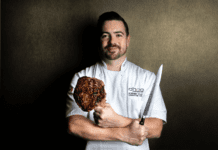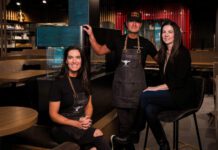The domino effect of the pandemic shutdowns has altered the foodservice landscape dramatically. Dealers and suppliers will tell you the impact has been considerable in some quarters, although not as devastating in others.
Inventory demands have shifted, leading to a hard-fought battle for supplies. All this has to be managed in the wake of myriad challenges such as supply-chain interruptions, fluctuating exchange rates and equipment shortages.
Dealers, for their part, are learning to ride out the change, shifting their business models and fine tuning their inventory and market reach to adapt to the new realities of a COVID-19 world.
In the beginning
“Like everybody else, the first quarter started like normal,” says Tom Pitera, CEO and executive chairman for Russell Hendrix in Vancouver. “The impact was really channel specific, with independents and chains being affected the most, especially in April.” Not surprisingly, the shutdowns in March led to a ripple effect throughout the dealer/supplier network, he says. At the macro level, Pitera estimates revenues dropped by 50 per cent on average throughout the community, “Anyone in the foodservice market saw a significant impact on volumes at that point in time.”
In early April, Russell Hendrix held two town-hall meetings with all its suppliers to discuss their needs in the coming months and ensure there would be an ongoing flow of product. “Having those meetings at the start of the pandemic helped solidify our strategies. We were able to avoid disruption in supply by taking preventative measures and adjusting purchases accordingly.”
Kristy Barber, owner of Hamilton-based Avondale Restaurant Equipment, was one of many who were blindsided by the disruption. “We were on an upward growth [trajectory] prior to February. April hit us the hardest when revenues dropped by 50 per cent. I’d say we’ve taken a rewind by about four years in terms of revenues. But we’ve since been rebounding as restaurants and facilities continue to re-open.”
She says having a varied customer base that includes small foodservice outlets to universities and healthcare facilities has been beneficial. “The sector experiencing the biggest hit has been independent sit-down restaurants. What was taken from us there, we’re adding to long-term care and universities.”
Like many dealers, her first order of the day was to source personal protective equipment PPE. “Getting it at the time was very, very difficult.” When supply for barriers was scarce, she tapped into local suppliers to design and build customized products, so they could offer turnkey design/build/install solutions. “That was big for us.”
She also focused almost exclusively on sourcing product from Canadian warehouses, to avoid issues around cross-border logistics. “Even if the product is there, getting it to Canada can be challenging. It’s not terrible, but it could be better.”
Winning the price war
In an increasingly competitive market, price wars are inevitable. “Unfortunately for some, there is that race to the bottom in terms of pricing. Our goal is not necessarily to sell on price,” Barber says. “I’ve said to clients, we’re not a Costco. There’s more to it than that. We go to market as a value add.”
That value-add lies in the relationships that have been built between suppliers, dealers and their customers, says Andrew Rodricks, vice-president of Sales and Marketing at R.E.D. Canada in Newmarket, Ont. “The restaurant-equipment business is one of the last bastions of a relationship-based business. It’s not always about a lower price. Ongoing service is really integral to that relationship.”
As a buying group, R.E.D.’s strengths lie in servicing the small- to medium-sized dealerships who rely heavily on personal support, he adds. “Medium- and smaller-sized dealers seem to have fared better than national conglomerates. Because they operate their own facilities, they can better cut down expenses and have managed to stay relatively healthy throughout the challenges.”
With many shifting a portion of their efforts to the education and healthcare sectors, knowledge is key, Rodricks notes. “Customers are relying on the expertise of our dealers to help them not just with kitchens, but other facets of their operations.”
The online factor
Online capabilities, from sales to training, have moved to the top of the priority list for many. Barber says they had to halt an initial website-makeover project to offer relevant products prioritized by specific vendors. “That’s not a quick process, but e-commerce is a vital piece that will become even more so when we come out of COVID-19.”
David Flanagan, president, iFoodEquipment.ca in Moncton, primarily services Canadian customers from coast to coast online. Sales have shown significant growth following a two-week lull when COVID-19 first hit. “It exploded beyond anything we had done before.”
The company growth has continued on a trajectory following a “re-set period”, during which he hired sales representatives that lost their positions at other dealerships. “We were able to capitalize on that to grow our sales to hospitals and nursing homes,” Flanagan says.
Items in extremely high demand include refrigeration and freezer units, as well as patio equipment. “A lot of operators are pivoting to re-position themselves by getting into new categories. We ran out of glass door and chest freezers, as well as patio heaters. We also saw an uptick in ice-cream dipping cabinets.”
Another product line eclipsing others is takeout containers, Flanagan says. “We saw a big uptick in sales there. Operators who had mothballed operations for a couple of months began opening up takeout and grab and go.”
Supply-chain struggles
Flanagan admits buying from U.S. suppliers has had its ups and downs. “Prices started creeping up because of exchange rates, which was affecting our margins. When that happens, we try to eat the price variances as much as we can. Now the Canadian dollar has rebounded, so it’s better.”
While demand is steady, particularly for safety and sanitization equipment, the biggest challenge for HESCO Foodservice Supply & Design Edmonton has been a broken-down supply chain, says president Cory Wagner. “We saw a big run on stock items, so had to source from other suppliers in China, the U.S. and Europe. Some U.S. factories shut down, so getting certain equipment up here has been a bit of a challenge. I’d say now we’re 90 per cent back to normal.”
Timing was a big issue. When HESCO tried to source foaming pumps out of China, for example, it was a six-week wait. “We started designing our own, working with a custom metalworker,” Wagner explains.
“We’re trying to be as entrepreneurial as possible,” says Adam Ungarian, HESCO vice-president, Sales. “We’re also working with architects and engineers around new rules on kitchen design so we can speak with authority.” “We’ve also put a lot of focus on the purchasing side, expanding vendor relationships and hiring specialists in areas like disposable and to-go containers,” Cory adds.
A shifting future
The struggles for dealers and operators is far from over, Pitera notes. “As we talk to operators across all channels, one of the biggest questions is what happens when patios close and the possibility of another surge as we get into the colder months. What can they do to augment their business?”
Takeout and delivery will be an even more important element moving forward, he believes. “Operators are also talking about ghost kitchens as an opportunity to service marketplaces without the front-of-house costs of a service establishment. It’s early stage, but it’s certainly being discussed.”
For now, it’s all about the planning, he adds. “We’re making contingency plans in the hopes we won’t have to implement them. But we all have to be prepared at the end of the day.”
By Denise Deveau

















